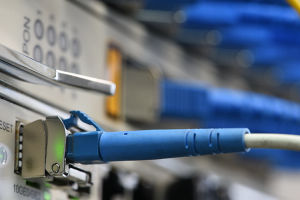 The digital age has ushered in an era of unprecedented access to information and technology, and schools are not exempt from this trend. As education moves towards a full cloud environment, the need for high-speed internet connectivity becomes ever more important. In response, the Department for Education (DfE) has recently recommended that schools should have a symmetrical internet connection with a minimum of 100Mbps. In this blog post, we will explore why this recommendation is crucial for schools and the benefits it can bring.
The digital age has ushered in an era of unprecedented access to information and technology, and schools are not exempt from this trend. As education moves towards a full cloud environment, the need for high-speed internet connectivity becomes ever more important. In response, the Department for Education (DfE) has recently recommended that schools should have a symmetrical internet connection with a minimum of 100Mbps. In this blog post, we will explore why this recommendation is crucial for schools and the benefits it can bring.
Firstly, let’s define what a symmetrical internet connection is. In simple terms, it means that the download and upload speeds are equal. This is in contrast to asymmetrical internet connections, such as Fibre to the Cabinet (FTTC), which are more common, where the download speed is higher than the upload speed. The reason why symmetrical internet connections are important is that they allow for more efficient use of internet-based tools and applications. This is especially relevant in education, where online resources are increasingly used to deliver lessons and assessments.
The DfE’s recommendation for schools to have a symmetrical internet connection with a minimum of 100Mbps is based on a number of factors. Firstly, it recognises the increasing importance of cloud-based technologies in education. As more schools move towards a full cloud environment, the need for high-speed internet connectivity becomes more pressing. This is because cloud-based tools and applications require fast and reliable internet access to function properly. Without this, schools may experience slow loading times, buffering, or even complete downtime, which can severely disrupt teaching and learning.
In addition, the DfE’s recommendation is based on the need for schools to deliver high-quality remote learning. The COVID-19 pandemic has accelerated the adoption of remote learning in schools, with many students and teachers working from home. This has placed unprecedented demand on internet connectivity, with many schools struggling to deliver high-quality online lessons due to slow or unreliable internet access. By providing schools with a symmetrical internet connection with a minimum of 100Mbps, the DfE hopes to ensure that schools can deliver remote learning effectively and efficiently.
So, what are the benefits of a symmetrical internet connection with a minimum of 100Mbps for schools? Firstly, it allows for more efficient use of online tools and applications. With faster and more reliable internet access, teachers and students can access online resources more quickly and easily, and lessons can be delivered more smoothly. This can help to improve engagement and reduce frustration, making for a more positive learning experience.
In addition, a symmetrical internet connection with a minimum of 100Mbps can help to improve collaboration and communication in schools. With faster and more reliable internet access, teachers and students can collaborate on projects more easily, share resources more quickly, and communicate more effectively. This can help to foster a more collaborative and connected learning environment, which is beneficial for both teachers and students.
Finally, a symmetrical internet connection with a minimum of 100Mbps can help to future-proof schools for the digital age. As technology continues to evolve, schools will need to keep up with the latest tools and applications to deliver the best possible education to students. By providing high-speed internet connectivity, schools can ensure that they are equipped to handle new technologies as they emerge, and that they can continue to provide a high-quality education to students for years to come.
In conclusion, the DfE’s recommendation for schools to have a symmetrical internet connection with a minimum of 100Mbps is a crucial step towards ensuring that schools are equipped for the digital age. By providing fast and reliable internet access, schools can make the most of online tools and applications, deliver high-quality remote learning, improve collaboration and communication, and future-proof themselves for the technologies of tomorrow.



